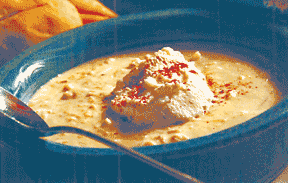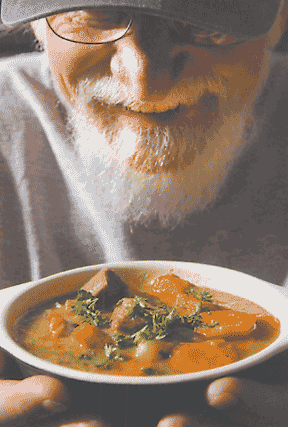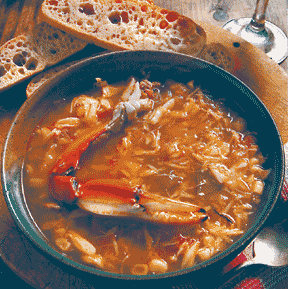 |
|||||||||||
|
|||||||||||
|
|||||||||||
|
Soup’s On!
A steaming new cookbook by Maryland’s crabbiest writerby Sandra Olivetti MartinCrab is coming our way. Already the beautiful swimmers are moving — crawling, swimming, floating in the currents — up the Bay and into the tributaries. Already crabbers have their boats and pots ready as they wait, impatiently, for waters to warm wind to slow and crabs to show. When you start cracking your first crabs of the season, overcome your winter-stoked gluttony to arrange for leftovers, and you’ll be well rewarded. For there’s a literature of ways to eat crab, created by Tidewater Marylanders who, in the days of abundance and self-reliance, could catch a crab in Chesapeake waters as easily as they could pick a tomato out of their garden. Many chapters of the literature are devoted to soup, and Maryland’s crabbiest writer, Whitey Schmidt of Crisfield, has collected and perfected it in his newest book of regional cuisine, Chesapeake Bay Soups. Thirty-eight recipes divided into six chapters take you from The Basics through the region’s waters and fields: Clam Chowder, Crab Soups, Fish Soups Oyster Stews and Vegetable Soups. Each recipe is named for one of the region’s rivers, but Schmidt takes his cooking inspiration wherever it strikes and uses poetic license in his naming. When you turn your crab picking into soup, you’ll have six recipes to choose from. Remember, Schmidt advises, to save a few claws. They’re the latest fashionable garnish to crab soups. To his cream of crab recipe, thick with whipping cream, he’s given the name Rhode River. Neighboring West River — where Schmidt long ago worked in the kitchen at Steamboat Landing — lends its name to his vegetable crab soup with its high-end secret ingredient. We’ve given you those recipes; for the other 36, you’ll have to buy the book. The Smell of InspirationAs has his career in books, Schmidt’s 10th book came to him while he was busy doing something else. “Here at my studio-kitchen, I like to have a soup simmering on the stove when I’m working on a new book or marketing my past ones,” Schmidt said. “You get to smell it all day long, so it’s a natural for me.” A garlic soup was on the stove the day this book was born. Refined as Patapsco River Garlic Soup, it’s the last recipe in this small, beautiful and handy hardcover book. The Road HereBack in 1980, Schmidt was busy with a different kind of job. His family’s automotive supply business, Tab Distributing, kept him on the road between Baltimore and Richmond. “I did that 20 years,” Schmidt recalls. “I traveled a lot of open highway, and I passed a lot of crab houses. I’d stop and pick a few crabs, usually a dozen. Thousands of miles adds up to a lot of crabs and beer, but I never counted the beer.” Somewhere along the road, as the umpteenth friend asked Schmidt to make a recommendation from his little black book of crab houses, the visits inspired Schmidt’s Official Crab Eaters’ Guide. In five years of pleasurable research, he visited, he claims, “all the crab houses on both shores, around the complete Bay, up one side and down the other, including all the back roads.” Published in 1985, book number one chronicled Schmidt’s experiences in 157 crab houses. In doing so, Schmidt had made for himself the kind of career that wage-slaves dream about. “Funny how things like that change your life,” Schmidt reflects. “I found out that you don’t write a book, you build it. When I tried to go to a publisher and [they] didn’t want to give me anything, that put me into another category.” He formed his own publishing house, naming it Marian Hartnett Press in honor of his mother. Self-publishing means hiring freelance editors and photographers, and scrounging art where he can. Often, he’s chosen heritage graphics, which are old enough to be out of copyright protection. Once, he borrowed Bay photographer Marion Warren’s distinctive images. Lately, he’s collaborated with Maryland photographer Vince Lupo, who sets up brilliant color shots that make Schmidt’s recipes look good enough to feed the queen.
On the Job“I prepped the soups in my studio-kitchen,” said Schmidt of the partnership that makes his work “really jump out. “We garnished them and selected a bowl, and Vince photographed them.” Comparing price and product, Schmidt matches printers to the specifications for each book. This one, which he was determined to have at the neat size of seven and three-quarters inches square, was printed in Dallas at Taylor Specialty Books, whose usual business is high school yearbooks. Once the books are delivered — 5,000 copies of this one — Schmidt sets out on the most demanding part of his career, which he describes as “10 percent writing and 90 publicizing.” Schmidt’s experience in distribution and his easy-going persistence have made him the envy of self-publishing authors far and wide for his mastery of book placement and sales. “I took off around the Bay again,” Schmidt said. “Here it is 2007, and I’m still selling to the same places.” He’s been at it for a quarter century. The Official Crab Eaters’ Guide, led to Bayside dining guides first published in 1988 and reprinted in 1997. Next, in 1995, came two Bay Trippers, travel guides for the Bay’s Eastern and Western Shores. Finally, he settled on cookbooks. Crab Cook Book came out in 1990, followed in 1993 with The Flavor of the Chesapeake, including Warren’s famous photos. At the millennium, Schmidt wrote Chesapeake Bay’s Crabbiest Cookbook. In 2003, he switched seafoods in The Oyster Cookbook. “I love cooking, and I love doing it. Cookbooks have been very successful for me,” said Schmidt. Like his publishing house, Chesapeake Bay Soups rose from maternal inspiration. “I remember as far back as elementary school, coming home for lunch. My mother always had some kind of soup and grilled cheese,” he says, defining comfort food. From “family, friends, and eating in all those restaurants on the Bay,” Schmidt said, “I collect recipes and dabble and tweak, trying to make them better.” Often, better means richer. “If I’m going to cook it, I like to use butter and cream,” said Schmidt, whose heart held him accountable for his tastes a few years back. “I don’t take anything away from soup itself, from the way I want it to taste right. If you need to cut back, cut back on your helping.” $16.95 from Marian Hartnett Press: 888-876-3767; [email protected].Rhode River Cream of Crab Soup
|
|||||||||||
 |
photo by Vince Lupo© Marian Hartnett PressRhode River Cream of Crab Soup. |
2 Tbs. flour
2 cups fish stock
2 cups whipping cream
1 tsp. Worcestershire sauce
1 tsp. salt
1⁄8 tsp. white pepper
1 bay leaf
Dash of Tabasco sauce
1 pound crab meat
1⁄4 cup sherry
Lightly whipped cream and paprika for garnish
Melt the butter in a soup pot over low heat and saute the onion and shallots until tender. Whisk in the flour and cook over medium heat, stirring constantly, for about 2 minutes. Do not brown the flour. Remove from the heat and whisk in the stock and cream.
Return to heat and stir frequently until the mixture thickens, about 10 minutes. Add the Worcestershire sauce, salt, pepper, bay leaf, Tabasco sauce, crabmeat and sherry. Lower the heat and simmer for 20 minutes. Remove the bay leaf, ladle into warmed soup bowls, top with whipped cream and garnish with paprika.
West River Vegetable Crab Soup
2 quarts vegetable stock
1 leek, white part only, sliced
2 medium onions, chopped
2 ribs celery, peeled and chopped
3 medium carrots cut into small pieces
3 medium potatoes cut into small pieces
1⁄2 cup chopped cabbage
1 cup green beans cut into 1-inch lengths
6-8 tomatoes, peeled, seeded, and chopped, or 2 to 3 cups canned tomatoes
1 small T-bone steak
1 cup corn kernels
1 cup lima beans
Salt and freshly ground black pepper
1 pound lump crabmeat
Seafood seasoning to taste
Pour the vegetable stock into a heavy stockpot. Add the leek, onions, celery carrots, potatoes, and T-bone steak (whole). Simmer over low heat until vegetables are tender, about 40 minutes.
Remove the cooked beef. Cut meat into small dice, discard the bone and return the beef pieces to the pot. Add the corn and lima beans and continue to cook until all the vegetables are tender, 20 to 30 minutes. Add crabmeat and salt, pepper, and seafood seasoning to taste. Heat through, stirring gently and serve.
|
Current Issue \\ Archives \\ Subscriptions \\ Clasified Advertising \\ Display Advertising |


